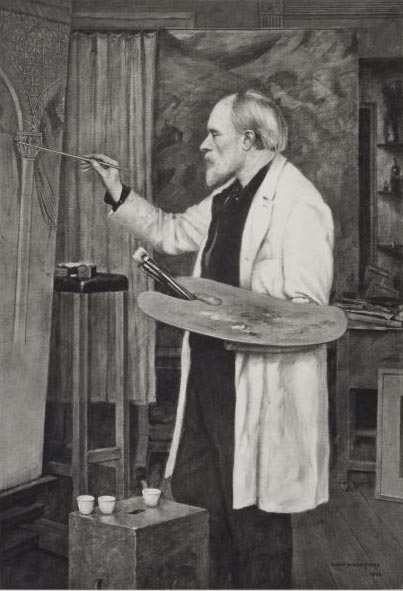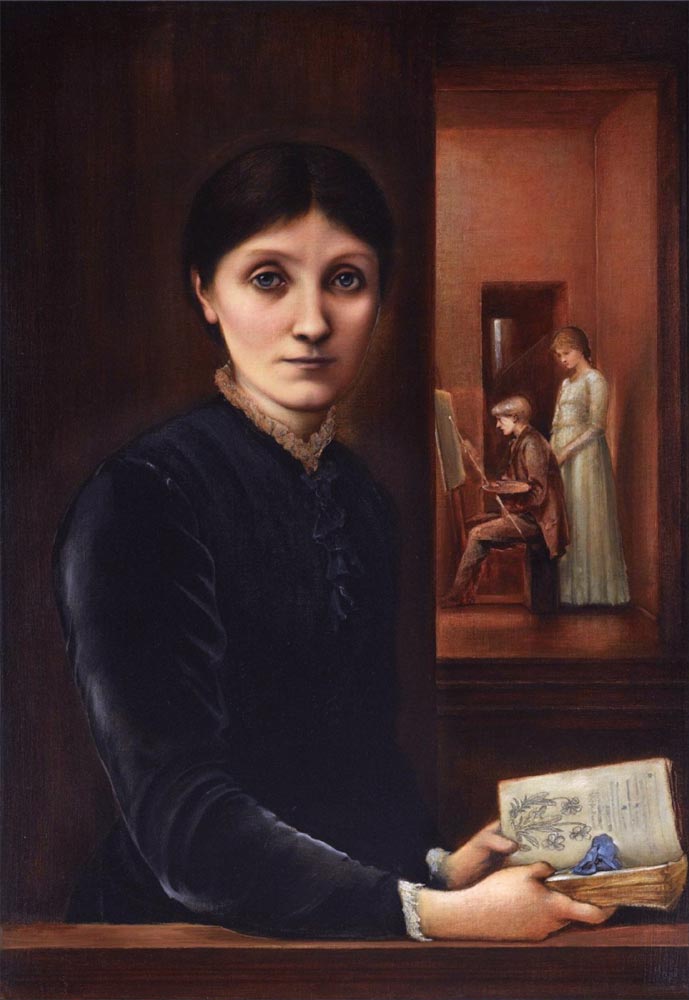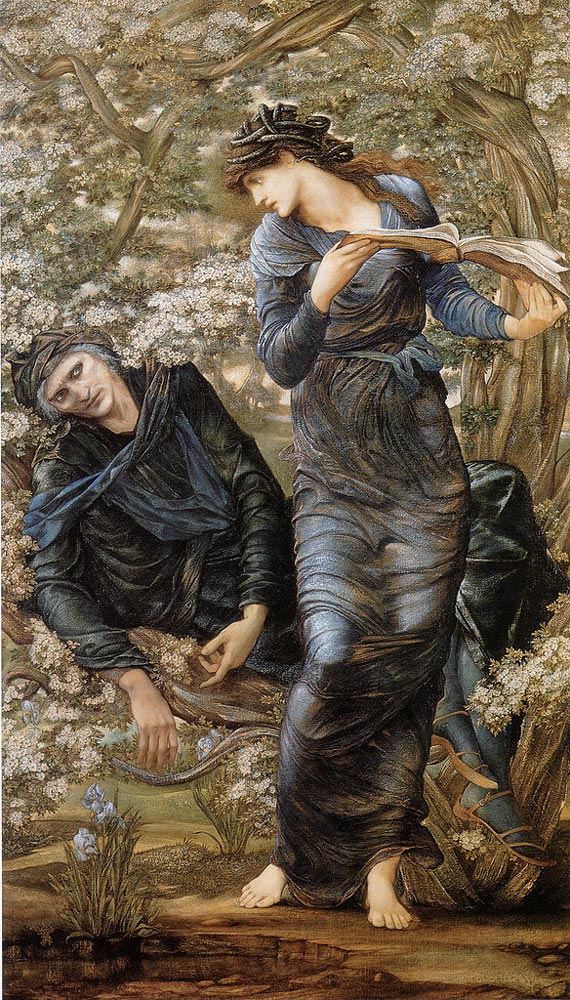| Edward Burne-Jones | |
|---|---|
 |
|
| Born | Aug. 28, 1833 Birmingham, England, U. K. |
| Died | June 17, 1898 (at age 64) London, England, U. K. |
| Nationality | British |
| Movement | Pre-Raphaelite Brotherhood, Aesthetic Movement, Arts and Crafts Movement |
| Field | Painting |
| Works | View Complete Works |
Sir Edward Burne-Jones, considered one of the greatest nineteenth-century English painters, was also an illustrator, and designer of tapestry and stained glass windows. His work is associated with the latter phase of the Pre-Raphaelite movement in art, believing that art should be valued as beauty, and a sensual response as opposed to a moral subject defined. His paintings reflected romantic dreams, and picturesque scenes of how one would want things to be. His initial art received and endured a great deal of criticism. With time and wider exposure of his works, he became a requested and widely- respected artist.
Background
Edward Coley Burne-Jones was born in 1833 to a Welsh frame-maker, in Birmingham, England. His mother died, days after he was born, and he was raised by his grieving father, and family housekeeper. Burne-Jones first attended King Edward VI grammar school in 1844, continuing to the Birmingham School of Art, from 1848-1852. He then attended Exeter College in Oxford, to study theology, as his first intention was to become a church minister. In Oxford, he became friends with William Morris, and together they formed The Brotherhood, made up of those with a mutual interest in poetry, reading John Ruskin, and Tennyson. This group visited churches and worshipped the Middle Ages and its literature.
A great influence on Edward’s initial work was Dante Gabriel Rossetti, who was asked to be a contributor to their Oxford and Cambridge Magazine, which Morris founded in 1856, promoting the ideas of The Brotherhood. Rossetti influenced Edward to pursue his art career, becoming his mentor, and Edward left college before even graduating with an art degree. In 1860, Edward married, becoming father to Philip, who later became a portrait painter, and Margaret. In these early days of his career, Burne-Jones had an extraordinary skill of invention as a designer.
Period of Defining Style
 Burne-Jones’s first sketch in oils was made for Bradfield College in 1856. It was his first, of a large series of cartoons, for stained glass. In 1857, Burne-Jones joined Morris in decorating the walls of the Oxford Union, which was Rossetti’s idea. Because the artists had not yet mastered fresco techniques, the pictures peeled from the walls before they had been completed. In 1858, Edward decorated a cabinet with the Prioress’s Tale from Chaucer’s Canterbury Tales. This was his first illustration of a poet he respected, and who became the inspiration of further endless subjects.
Burne-Jones’s first sketch in oils was made for Bradfield College in 1856. It was his first, of a large series of cartoons, for stained glass. In 1857, Burne-Jones joined Morris in decorating the walls of the Oxford Union, which was Rossetti’s idea. Because the artists had not yet mastered fresco techniques, the pictures peeled from the walls before they had been completed. In 1858, Edward decorated a cabinet with the Prioress’s Tale from Chaucer’s Canterbury Tales. This was his first illustration of a poet he respected, and who became the inspiration of further endless subjects.
A trip to Italy in 1859 helped to build Burne-Jones’s reputation for being a painter. There he found the Sienese School of painting which emphasized decorative beauty and the elegance and grace of Gothic art. In 1860, he painted Sidonia von Bork and Clara von Bork, both watercolors, and also illustrated the 1849 Gothic novel by Wilde. In 1861, William Morris formed the decorative arts firm of Morris, Marshall, Faulkner, and Company, with Rossetti, Burne-Jones, Charles Faulkner, and Peter Marshall. This firm undertook carvings, stained glass windows, metal-work, and paper hangings. They also specialized in textiles such as chintzes, and carpets.
The adornment of churches was an important part of their business. Burne-Jones designed stained glass windows, and panel figures for a royal project at St. James Palace, among others, and his work was shown at an 1862 International Exhibition, attracting much attention, and within a few years, his work flourished. In 1871 Burne-Jones designed windows at All Saints, and Christ Church Cathedral. His last major decorating commission before Morris’s death in 1896 was at Stanmore Hall, which was his most extensive undertaking. It included a series of tapestries based on the story of the Holy Grail.
Watercolors, Oils, and Increasing Recognition
 In 1864, Burne-Jones joined the Society of Painters in Water-Colours, exhibiting The Merciful Knight. This was the first time that he had exhibited a painting in which his own artistic personality showed, without heavy influence of others. The following six years, he worked on a series of watercolor paintings at this gallery. In 1866, an affair with Maria Zambaco, a Greek model of a portrait commissioned, caused Burne-Jones to end his association with the Society. His paintings began resembling the face of this model and daughter of the requester, therefore causing a scandal. From 1870 to 1877, referred to as his silent period, only two works were placed on exhibition at the Dudley Gallery.
In 1864, Burne-Jones joined the Society of Painters in Water-Colours, exhibiting The Merciful Knight. This was the first time that he had exhibited a painting in which his own artistic personality showed, without heavy influence of others. The following six years, he worked on a series of watercolor paintings at this gallery. In 1866, an affair with Maria Zambaco, a Greek model of a portrait commissioned, caused Burne-Jones to end his association with the Society. His paintings began resembling the face of this model and daughter of the requester, therefore causing a scandal. From 1870 to 1877, referred to as his silent period, only two works were placed on exhibition at the Dudley Gallery.
Burne-Jones initially painted in watercolors, but a curator’s mistake actually sparked him to switch to oils. His watercolor Love among the Ruins, was destroyed by a restorer, thinking it was an oil painting, so Burne-Jones reproduced the same painting in oils. His first oil originals were the Briar Rose series, the Golden Stairs, Laus Veneris, the Pygmalion series, and The Mirror of Venus. This time of switching to oils, marked a partnership with Frederick Hollyer, a fine-art photographer, who helped to give Burne-Jones a wider audience for his beautiful paintings.
Artwork Success and Decline
In 1877, Burne-Jones’s exhibition at the Grosvenor Gallery, with Days of Creation, The Beguiling of Merlin, and Mirror of Venus, made him an overnight success as an artist.
In 1879, with the Annunciation, the second series of Pygmalion, and the Image, his paintings depicted a more sober and subdued mood with soft and delicate tints, as opposed to the brilliant colors used previously. The somber mood of his paintings were not particularly met with success.
In 1885, Burne-Jones was elected as an Associate of the Royal Academy, where he also exhibited The Depths of the Sea, Perseus series, the Brazen Tower, and The Star of Bethlehem. His somber mood in art could have been due to his health issues, since he was suffering from rapid heart-beat and poor eyesight.
In 1892, the New Gallery exhibition featured Burne-Jones’s portrait paintings, of which there were only a few. In 1894, Burne-Jones was knighted, but in poor health again. This same year, Burne-Jones undertook a commission to design sets and costumes for the Lyceum Theatre production of King Arthur, which toured London and later America. He did not care for the way that it looked on stage, as it was not romanticized enough for his liking. Burne-Jones was under constant pressure of his own ideas.
Burne-Jones had an obsessive attention to detail, and was a bit of a perfectionist. He would sketch a large number of preparatory drawings before beginning a painting. He was a rather high-strung individual, with a love of ancient legend. Because he identified himself in his art, he would often have a nervous collapse after completing any major work. Some of his work was quite extensive, such as Arthur in Avalon, which he began when he was 49 years old. This work was twenty-four feet long, and was not completed until before his death at age 62. In 1890, his health began to decline, due to the stress that he put upon himself. He was also deeply affected by the death of his friend and colleague William Morris, in 1896. Sir Edward Burne-Jones died suddenly, in 1898, at his home in England.
The Many Gifts of to the Art World
Sir Edward Coley Burne-Jones was skilled in designing ceramic tiles, stained glass, jewelery, tapestries, theater sets, and illustrating as well as painting in watercolors and oils. He painted on canvas, but his preliminary drawings were often made on vellum, or animal skin. He became a leader of the new Aesthetic Movement, which promoted the art of nature and beauty, with his work The Beguiling of Merlin, and opposed traditional classicism.
Although Burne-Jones used much of the same subject matter as Rossetti in his earlier works, he then developed his own style, emphasizing imaginative and romantic detail. His switch from watercolors to oil was born of accident and necessity, but continued it throughout his life. Burne-Jones wanted his paintings to reflect how people desire things to be, as opposed to a realistic depiction of life. He delighted in pure colors, and by highlighting in gold, gave a certain light to his works. Burne-Jones wanted his art to be something that never left the heart of the viewer, and is still being appreciated today in museums throughout the world.